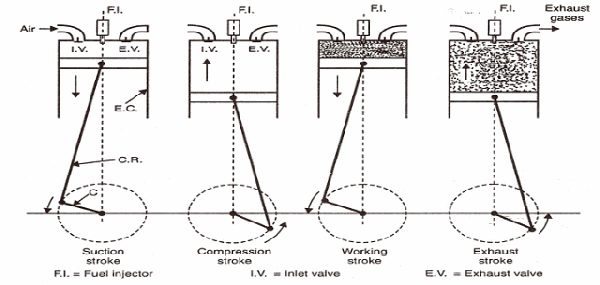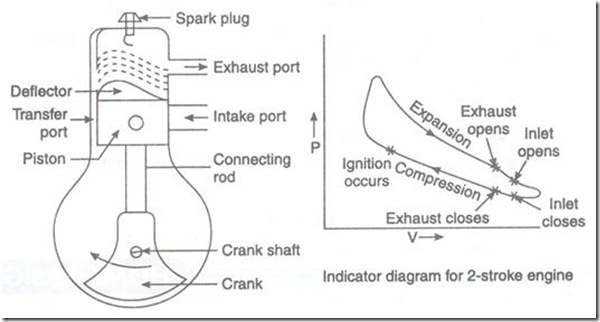To study two stroke and four stroke petrol engines.
AIM: To study two stroke and four stroke petrol engines.
APPARATUS: Model of two stroke and four stroke petrol engine.
THEORY: The engine which converts the heat energy into mechanical energy is known as heat engine.
1. WORKING PRINCIPLE OF FOUR STROKE PETROL ENGINES
There are four strokes which are as follows:
i) Suction stroke
ii) Compression stroke
iii) Expansion or working or power stroke
iv) Exhaust stroke
i) SUCTION STROKE: The suction stroke starts with the piston at top dead centre position. During this stroke, the piston moves downwards by means of crank shaft. The inlet valve is opened and the exhaust valve is closed. The partial vacuum created by the downward movement of the piston sucks in the fresh charge (mixture of air and petrol) from the carburetor through the inlet value. The stroke is completed during the half revolution (180O) of the crank shaft, which means at the end of the suction stroke, piston reaches the bottom head centre position.
Figure of Four Stroke SI Engine Cycle
ii) COMPRESSION STROKE: During this stroke the inlet and exhaust valves are closed and the piston returns from bottom dead centre position. As the piston moves up, the charge is compressed. During compression the pressure and temperature rises. This rise in temperature and pressure depends upon the compression ratio (in petrol engines the compression ratio generally varies between 6:1 and 9:1). Just before the completion of the compression stroke, the charge is ignited by means of an electric spark, produced at the spark plug.
iii) WORKING OR EXPANSION STROKE: The ignition of the compressed charge. Just before the completion of compression stroke, causes a rapid rise of temperature and pressure in the cylinder. During this stroke the inlet and exhaust values remain closed. The expansion of gases due to the heat of combustion exerts pressure on the piston due to which the piston moves downward, doing some useful work.
iv) EXHAUST STROKE: The exhaust value is opened and the inlet valve remain closed. The piston moves upward (from its BDC position) with the help of energy stored in the flywheel during the working stroke. The upward movement of the piston discharges the burnt gases through the exhaust value.
At the end of exhaust stroke, piston reaches its TDC position and the next cycle starts
Working Principles of 2-Stroke petrol engine
The working principle of 2-Stroke petrol engine is discussed below:-
1) 1st Stroke: To start with let us assume the piston to be at its B.D.C. position. The arrangement of the ports is such that the piston performs two jobs simultaneously.
As the piston starts rising from its B.D.C. position it closes the transfer port and the exhaust port. The charge (mixture, of the air and petrol) which is already there in the cylinder, as the result of the previous running of the engine is compressed at the same time with the upward movement of the piston vacuum is created in the crank case (which is gas tight). As son as the inlet port is uncovered; the fresh change in sucked in the crank case. The charging is continued until the crank case and the space in the cylinder beneath the piston is filled with the charge. As the end of third stroke, the piston reached the T.D.C. position.
2) 2nd Stroke: Slightly before the completion of the compression stroke, the compressed charge is ignited by means of a spark produced at the spark plug.
Figure of Two stroke SI Engine
Pressure is exerted on the crank of the piston due to the combustion of the piston is pushed in the downward direction producing some useful power. The downward movement of the will first close the inlet port and then it will compress the charge already sucked in the crank case.
Just the end of power stroke, the piston uncovered the exhaust port and the transfer port simultaneously the expanded gases start escaping through the exhaust port and the same time the fresh charge which is already compressed in the crank case, rushed into the cylinder through the transfer port and thus the cycle is repeated again.
The fresh charge coming into the cylinder also helps in exhausting the burnt gases out of the cylinder through the exhaust port. This is known as scavenging.


9 Responses to “To study two stroke and four stroke petrol engines | BME Lab Manual”
Abhishek
Thank u….
Abhishek
Thank for clear my concept
Abhas
Thnx for this practical, it helps me a lot
Arivu Chelvan
These stuffs are really useful… These notes are used both for understanding purpose and also to write (exam point of view)…Tq
Danish Saifi
These experimentaly stuffs are really useful. these notes are used for practically and to understand the working system for such types of engines. and helpful us for prepearing and also to write. I am thanked for clear my basic concept about such types of engines
Sweety Anchalia
Indeed an awesum notes for better understanding n making file…..thankew
Sajahan
Thanks for helping me out……..
SAKIBU FRANCIS
Can you please send me a video animation of how a transfer port works on a 2 stroke cycle
MANU P S
It’s really helpful